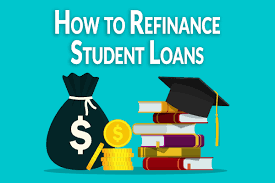- Student loan refinancing could help you get out of debt sooner and reduce your monthly payments, making it a smart option to consider for many student loan borrowers.
- Before you refinance your loans, though, it’s important to research and compare lenders to determine which options work for you.
- It’s also important to shop around for the best loan rates to ensure that you’re saving money on what you owe.
If you have student loan debt, refinancing can be a smart move – one that can lower your interest rate and also streamline multiple loans into a single debt. Before taking this step, however, it’s important to lay the groundwork to get the most competitive loan possible.
This process can include a range of factors, like reviewing and improving your credit profile and researching multiple lenders. But by adequately preparing yourself for the refinance process, it may be easier to find the right options and save money over the long run.
1. Determine if refinancing is the best option
Refinancing a student loan could help you get out of debt sooner and possibly reduce your monthly payment obligations, but this hinges on whether you qualify for a good deal.
Start by checking your credit reports and credit scores to determine where you stand. You typically need a good credit score — usually defined as a FICO score 670 or higher — to qualify for student loan refinancing without a cosigner. If you find that your credit isn’t in the best shape, you can work to improve your credit before you try to refinance.
It’s equally important to consider the type of loan you currently have, the remaining loan term, the current interest rate and your monthly payment. Here are some key advantages and drawbacks to consider before refinancing. .

Pros
- Lower interest rate: Most people refinance to get a lower interest rate. Getting a lower rate means you could pay less interest over the loan term if you don’t extend your repayment term.
- More affordable payments: Refinancing is a good idea if you have an unmanageable monthly payment. Extending your repayment term may ultimately increase the interest you pay, but it will also lower your monthly bill.

Cons
- Forfeiture of key benefits: Refinancing your federal loans means losing federal protections — like federal forbearance and income-driven repayment plans — since it can only be done through private lenders.
- Increased borrowing costs: Refinancing into a longer repayment period could increase the interest you’ll pay on your loan. If it is almost paid off, it could be cheaper to stick with the loan you already have. If you’re at the start of your repayment period, on the other hand, refinancing may make more sense. You may also incur higher borrowing costs if you switch from a fixed-rate loan to a variable-rate loan.
When in doubt, use a student loan calculator to compare your current loan with any new loans you’re considering.
If you have federal student loans and are on the fence about refinancing, proceed with caution. Once you move forward with a private loan, you can’t revert back to a federal student loan to take advantage of the key benefits they offer, as noted in a warning issued by the Consumer Financial Protection Bureau. So, do your homework to ensure you’re making a smart financial move.
2. Research lenders
If you decide to refinance your student loans, the next step is to compile a list of lenders that could work for you. When researching lenders, you will want to consider:
- Whether the interest rate you are quoted is fixed or variable.
- If the lender allows co-signers to help boost your approval odds.
- If the refinanced loan would have simple or compound interest.
- If the lender offers bonuses or incentives for refinancing.
- What payment options are available and if they work for your finances.
- If flexible due dates and skip a-payment perks are available.
- How the fees assessed by the lender stack up to the competition.
- How the lender is perceived by past and current borrowers.
- What reviews say about the lender’s responsiveness to inquiries and if borrowers are satisfied.
3. Shop for the best loan options
Researching student loan refinancing rates and checking with at least three lenders on your shortlist to find the best rate is a key element in successfully refinancing your student loans.
Each lender uses different criteria to determine your borrowing eligibility and interest rates. Your rate will likely vary between one lender and the next and can be impacted by factors like your credit history, the repayment term you select, and whether you choose fixed or variable interest on the loan.
That said, rate shopping should be something you do anytime you’re looking for a new loan or credit card. In general, the higher your rate, the higher your monthly payments. However, qualifying for a loan at a lower rate can lower your monthly payments.
Compare lender rates and fees online before applying to refinance your loans. If a lender offers a prequalification tool, take advantage; these applications require only a soft credit inquiry on your credit report. Getting prequalified can help you see the rates and loan terms you might qualify for if you refinanced. You can use this information to see if refinancing would make you better off regarding your monthly payment or total interest paid.
4. Submit a loan application
Once you’ve narrowed your shortlist to your preferred lender and loan offer, you must complete an official loan application. Even if you went through a lender’s prequalification process, you must complete this before your loan can be approved.
The lender will likely run a hard credit inquiry to access your full credit report. The lender will also want additional information you didn’t include on your prequalification form. If you’re applying with a co-signer, you’ll need to also provide their information.
You may need to provide the lender with copies of documents and information such as:
- Social Security number (SSN).
- Driver’s license or government ID.
- Loan payoff statements from existing student loan lenders or servicers.
- Proof of graduation.
- Proof of employment (pay stubs, W-2, etc.).
Most lenders make it easy to apply online for student loan refinancing in minutes. You could also hear back as soon as the same day or next business day. Funding timelines vary by lender, though, so it’s worth inquiring before applying to confirm.
Upon approval, the final step of the application process is to review and sign your loan documents. Technology has made this step considerably easier. Where you once had to sign loan documents in person or fax or mail them in, most student loan companies now handle their entire process online for ultimate convenience.
5. Transfer payments to your new lender
After the new loan closes, you will begin making payments on your new loan just like you were with your old one. However, your new lender may not immediately pay off your former loans. Sometimes the process can take a few weeks. Continue making any student loan payments that come due in the meantime so you don’t face late fees or potentially negative credit reporting.
Once your student loan refinance is complete and the debt has been transferred, you should receive a payoff letter from your old lender. You will need to create an account login with your new loan servicing company and begin making payments on your refinanced loan.
Keep an eye out for correspondence from the new lender identifying your first bill due date. Many lenders let you choose a date each month that works best for your schedule and budget, and some will offer a discounted rate if you enroll in autopay.
Frequently asked questions
- In general, you’ll need to have a credit score in the mid- to high 600s, a debt-to-income ratio of less than 43 percent and a source of steady income to refinance a student loan, but the requirements vary by lender. Getting pre-qualified is an excellent way to see if you’re eligible for student loan refinancing. While prequalification doesn’t guarantee that you’ll be approved, it can help you see if you meet the minimum criteria set by lenders.
- The timeline for completing the refinance process can vary based on the lender you use. While the application process with some lenders can be relatively quick, it can take time for your existing loan to be paid off by the new lender. In some cases, this may take between 30 to 45 days to complete the process.
- Yes, federal student loans can be refinanced with private lenders. However, it is important to carefully weigh the potential pros and cons of refinancing federal student loans with private loans, as private student loans do not offer the same benefits as federal student loans, such as deferment and forbearance.
- Some lenders allow you to transfer student loans to someone else. Some parents do this with loans they took out for their child’s education, transferring those loans to the adult child once they’re in the workforce. Keep in mind, though, that the loan will have new terms and new rates, which are based on the new borrower’s credit.
- Many lenders refinance student loans for people with bad credit, although if a lender does accept a lower credit score, it will almost certainly offer higher rates. As with new student loans, you can often apply for refinancing with a creditworthy co-signer, which could help you get qualified if you have poor credit.
- When you apply to a refinance lender, the resulting hard inquiry can knock a few points off your credit score. However, this impact is temporary and likely won’t do significant damage.
If you get approved, the resulting opening of the new loan account and closing of the original accounts can also temporarily impact your length of credit history, which is a factor in your credit score. Again, the impact is usually minor and temporary. Refinancing could improve your score in the long term if it helps you more consistently make payments on time and in full.





